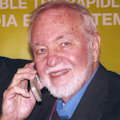The Si4206 Aero I GSM/GPRS transceiver (TX) integrates all radio functions into a single package, except for the input surface-acoustic-wave (SAW) filters, output power amplifiers, and the antenna switch (see the figure). As a result, this Silicon Laboratories chip eliminates approximately 70 external discrete components, reducing pc-board area by up to 75%. The chip can be used with most available baseband chips.
Designed for the ultra-compact cell-phone market, the Si4206 integrates the synthesizers, interface circuitry, and the most sensitive components, such as RF/IF voltage-controlled oscillator (VCO) loop filters, varactors, and other tuning components. This three-band transceiver covers the 850 or 900 GSM, DCS 1800, and PCS 1900 bands. The receive path uses a low IF (100 kHz) with DSP filtering to get rid of the dc offset problems of direct conversion. The transmitter employs a 400-MHz offset design. In the Aero I+ version, even the digitally controlled crystal oscillator (DCXO) is built in, eliminating the need for an external temperature-compensated crystal oscillator (TCXO). Only a 13- or 26-MHz crystal is required.
The Si4206, made with standard 0.18-µm CMOS, comes in an 8- by 8-mm LGA package. Prices start at $5.34 in 10,000-unit lots. An evaluation board also is available.
Silicon Laboratories www.silabs.comAbout the Author

Louis E. Frenzel
Click here to find more of Lou's articles on Electronic Design.